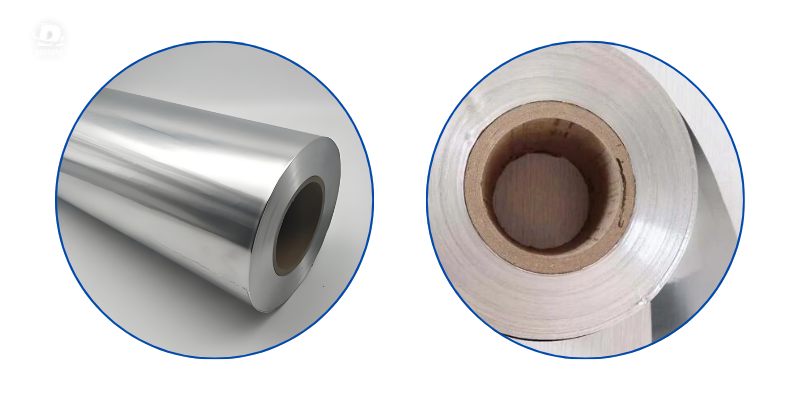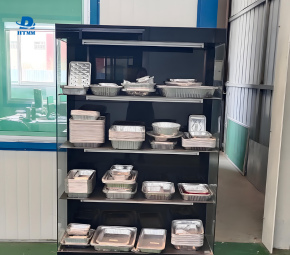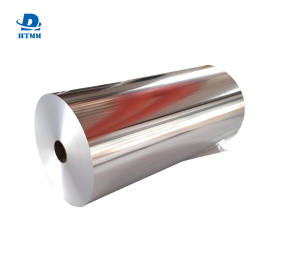While shopping, though, many consumers observe that food-grade household aluminum foil available on the market can be found in two distinct forms “regular/standard foil” and “heavy-duty foil.” Although the two types of food-grade aluminum foil may appear identical, they are not the same when it comes to product specifications, product performance, and use. The result is that using the wrong foil can diminish your experience and waste your money as they do serve distinct uses. Today, we will compare the two types of aluminum foil food packaging: including specifications and use cases so that you can hopefully find the best product and suit your household needs.
From specifications, the main difference between “standard” food-grade household aluminum foil and “heavy-duty” food-grade household aluminum foil is specifications. The first and most important specification is the thickness, which causes the performance differences of foil, where the width accommodates different use cases. The totality of the specifications are the product’s “use boundaries” boundaries.

Standard food-grade household aluminum foil is generally marketed between 0.008 and 0.015 mm in thickness. This thickness represents a fairly good mix of bending and basic sealing properties while being lightweight. Because of its thinness, care must be taken when unfolding standard foil as too much force can easily tear it. While unfurling it within a kitchen, punctures can theoretically occur from sharp ingredients like meats with bones, or shellfish that have hard shells, but these should be rare occurrences. The thin and lightweight properties of the foil allows it to flex and be shaped much easier than heavier weights without wrinkling, making it the better foil for oddly shaped containers (surfaces like bowl rims, and edges of baking pans).
Heavy duty food-grade household aluminum foil is much thicker, typically marketed between 0.016 to 0.02mm, while certain products designed for high stress applications may be as thick as 0.025 mm. Thick foil weight will also feel heavier because of its weight (increased thickness = increased weight). The sheet of heavy-duty foil is thicker, so it is also not affected if it is forceful unwound may wrinkle, and it will be much more tear resistant. If wrapping sharp items like bone-in steak or crabs, heavy-duty foil should not puncture when used, as opposed to standard foil. While repeated creasing the heavy duty foil will change its structural integrity, it will at least show minimal cracking.
Besides thickness, the two also have specific widths, both optimized for "scenario adaptations." Standard food-grade household aluminum foil typically comes in widths ranging from 28cm to 30cm; 28cm and 30cm are the most common for home users. —The 28cm width is good for wrapping individual ingredients (chicken breast or salmon fillet) or covering small bowls and plates, whereas the 30cm width fits standard household baking pans, and it can cover the perimeter fully so no juices run over.
.png)
In contrast, the heavy-duty food-grade household aluminum foil for larger "scenario adaptations," widths are more commonly found in 30cm to 45cm. Some brands also provide custom widths in excess of 50cm. The common widths of heavy-duty household aluminum foil that are 30cm-35cm can fit medium to large household baking pans or racks, allowing full wrap of whole chickens, fish, or very large cuts of meat. The 40cm-45cm wide products tend to be better suited for commercial uses, where it can wrap any tray of roasted vegetables, stack them in layers before baking, or can be used for upper and base layers for outdoor grilling to keep food from direct contact with the charcoal.
Moreover, heavy-duty aluminum foil comes in a wide variety of length specifications. In addition to the standard 10-meter and 20-meter rolls, there are frequently “high-capacity” rolls available in lengths of 30 to 50 meters, intended for high-frequency users.
Many reputable brands of food-grade household aluminum foil include thickness and width specifications on the packaging. Regardless of whether the aluminum foil is standard or heavy-duty, these thickness and width specifications are clearly labeled. Thickness will be labelled in “millimetres, taking units or “micrometers”, (1mm = 1000μm). Because these thickness and width specifications are documented on the packaging, consumers are immediately able to differentiate product from product, excluding various forms of misleading advertising terms such as ‘thickened’ or “reinforced’ type.
Standard aluminum foil has lightweight, flexible characteristics and is the ‘basic choice’ for everyday cooking and storage in the home. Standard aluminum foil’s common uses are based on three main uses: light cooking, short-term storage, and basic protection.
In light cooking scenarios, standard aluminum foil is best suited for “low-temperature, short-duration” heating and baking. For instance, in home baking, it wraps butter or cheese to prevent melting and dripping at high temperatures. When steaming fish or ribs, covering the dish surface with foil reduces steam penetration, preserving the ingredients' original flavor. When reheating leftovers, lightly covering the bowl opening prevents moisture loss that dries out food while avoiding oil splatters inside the microwave.
Additionally, standard aluminum foil can create “simple foil parcels”—wrap potatoes or sweet potatoes before baking to distribute heat evenly while locking in moisture for a softer texture.
For short-term storage, aluminum foil serves as a “reliable helper” in the refrigerator. Wrapping cut watermelons or cantaloupes in it effectively blocks refrigerator odors while preventing moisture loss, extending fruit freshness. Wrapping leftover cooked foods (like roast chicken or braised dishes) in aluminum foil before placing them in storage containers prevents direct contact with plastic and enhances sealing, reducing bacterial growth.
Aluminum foil also acts as an effective "basic protective" tool in everyday tasks. For example, if you're cleaning an oven, line the bottom with aluminum foil. This way, if there are any drips, instead of the food residue going into the oven, it goes to the foil instead. Once you clean up, you just throw out the foil, not having to scrub anything extra! If you are cleaning metal (i.e. cast iron or stainless steel) cookware, you can take some aluminum foil, crumple it into a ball, dip it in a small amount of dish soap, and then scrub the bottom to remove the stubborn stains without worrying about scratches. These "little tricks" are why ordinary aluminum foil is such an incredibly economical and handy tool in everyday life.
Heavy-Duty Aluminum foil, due to its thick and heavy durability aspect, has also been specifically designed for heavy duty cooking, outdoor usages, commercial situations, and all other circumstances where overhead foil performance is needed. It helps to eliminate the everyday disappointments of regular aluminum foil with its flimsy and short usability.
Heavy-duty aluminum foil is footwear for high-heat cooking methods for recipes “at high temperatures and for long periods of time with large pieces of food.” When used as a complete wrap (not just a single use) the heavy-duty aluminum foil's gauge ensures that it withstands baking at broad temperatures ranges (e.g. 220°C–250°C) where standard foil might be suggested only for 200°C. Furthermore, heavy-duty aluminium foil maintains its integrity after 2–3 hours of baking (in the correct heat range), and holds up against damage either through oil absorption or thermal degradation. Heavy duty aluminum foil can also protect the edges of sharp bones from puncturing other foil, which helps maintain juices by creating internal dripping points. Aluminium foil's retention of heat energy ensures that juices an even cover with the overall food product.
Moreover, heavy duty aluminum foil works well for other forms of cooking methodology e.g., for water bath methods (as with cheesecake or crème caramel). Thoroughly sealing a mold containing ingredients with foam covers before placing it into hot water bath will help prevent moisture ingress inhibition with the sealed molds.
Outside, heavy-duty aluminum foil's ability to withstand its own inner heat is at a peak! The use of heavy-duty aluminum foil in camping and picnicking allows to produce high-quality charcoal grilled food while only wrapping the food in heavy-duty foil, or it becomes a “temporary container” by placing vegetables, meat, and spice in foil and wrapping tight to roast on hot coals. In this methods, the durability of the heavy-duty aluminum foil negates the use of any additional cookware so food can be produced quickly and easily.
For commercial or high volume household use, heavy-duty aluminum foil's "capacity and durability" are great; it can serve multiple people simultaneously, withstand reheating three-four times without ripping, which lessens our food waste from foil.
If your household engages in "light cooking + short-term storage", such as when you bake an occasional small pastry, re-heat leftover dinner, or refrigerate when camping fruit, then standard food-grade household aluminum foil will provide the best value and you will be happy with your purchase.
.png)
If your household is in the situation of "serving large roasting cuts of meat" (whole chickens, lamb racks), enjoying outdoor camping barbecues, or frequently hosting food gatherings for large group of friends and family, then you would benefit from heavy-duty food-grade household aluminum foil (0.015-0.02mm thick, 30-40cm width) which offers better durability and functional benefits to provide a better user experience as you won't frequently be thinking about replacing or prefering not to ripping foil that is limited in capacity.
Additionally, regardless of the type of foil, always verify "food-grade certification" printed on the product. Most reputable brands (e.g., HTMM foil) will easily identify food-grade household by "for food contact" and passing national food safety testing which means that there was no migration of harmful substance during high-temperature use and your family's health will be protected.
In conclusion, there is no “superiority or inferiority” of regular food-service aluminum foil or heavy-duty aluminum foil; there are only differences in usage circumstances. You can easily choose the best aluminum foil for your kitchen by accurately defining your usage needs and considering features like thickness and width; letting your “kitchen assistant” deliver value to your experience, convenience, and deliciousness into your food life.





